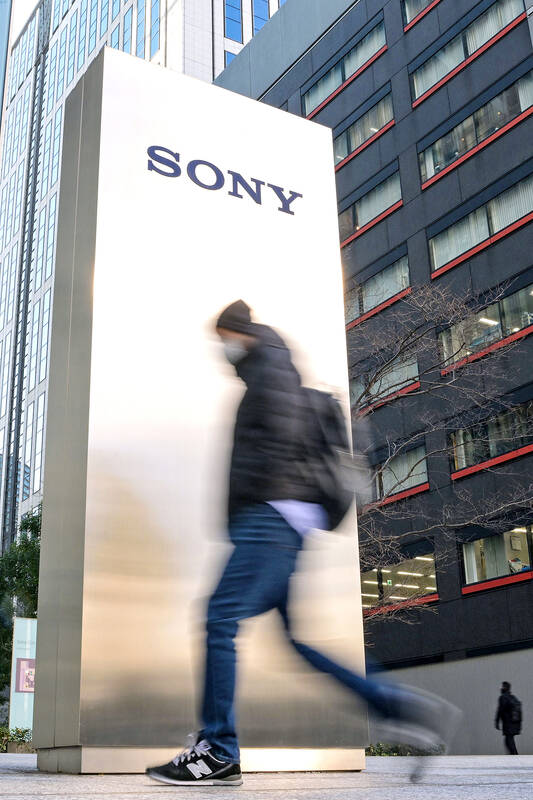Sony Group Corp said it is to list its financial arm in October next year, preparing for a major capital infusion after the media conglomerate cut the forecast for its core gaming division.
The company revealed plans for the partial sale after reporting earnings and revising its forecasts for the fiscal year through next month. The move to take Sony’s financial group public is to reverse a US$3.7 billion take-private deal concluded in 2020.
Sony trimmed its revenue forecast after sales of its flagship PlayStation 5 (PS5) came in roughly 1 million units lower than projected in the fourth quarter of last year, at 8.2 million consoles. The company also said it expects to sell 21 million units for the fiscal year, down from the previous forecast for 25 million units.

Photo: AFP
“Looking ahead, PS5 will enter the latter stage of its life cycle,” Sony senior vice president Naomi Matsuoka said. “As such, we will put more emphasis on the balance between profitability and sales. For this reason, we expect the annual sales pace of PS5 hardware will start falling from the next fiscal year.”
The Japanese firm now expects ¥12.3 trillion (US$81.7 billion) in sales for the year, down from ¥12.4 trillion previously. It reported revenue of ¥3.75 trillion and operating profit of ¥463.3 billion in the quarter ended December, in line with average analyst estimates.
“The result showed Sony spent a lot on promotions to sell the PS5, as the unit’s profitability deteriorated, but the number of units it shipped during the quarter was much weaker than expected,” Morningstar research director Kazunori Ito said.
The disappointing hardware sales came despite a strong quarter for software. Released in October last year as a PS5 exclusive, Marvel’s Spider-Man 2 sold 2.5 million copies in its first 24 hours, making it the fastest-selling debut from Sony’s in-house studios. It lifted expectations, along with Sony’s record number of users on the PlayStation network in December, that the PS5 was gaining momentum after years of limited supply.
Analysts remain cautious about Sony’s goal of selling more than 25 million PS5 units this fiscal year. The company released an updated edition of the hardware in October, making it more compact and power-efficient.
Key for the revenue-driving games division is sustaining momentum for the US$499 machine. On the market since late 2020, the PS5 has had a difficult time reaching Sony’s audience as production issues and COVID-19 pandemic-related shipping bottlenecks limited its supply for years.
Rivals Nintendo Co and Microsoft Corp are expected to release new hardware in time for the holiday season, raising the level of competition.
Sony might need to reshape its strategy in India, after a planned merger between its India unit and local media outfit Zee Entertainment Enterprises Ltd reached an impasse due to disagreement over leadership. The Zee deal was the centerpiece to the Japanese firm’s increased push into a market of 1.4 billion people, and investors would look for indications of Sony’s latest thinking on the matter.

Taiwan will prioritize the development of silicon photonics by taking advantage of its strength in the semiconductor industry to build another shield to protect the local economy, National Development Council (NDC) Minister Paul Liu (劉鏡清) said yesterday. Speaking at a meeting of the legislature’s Economics Committee, Liu said Taiwan already has the artificial intelligence (AI) industry as a shield, after the semiconductor industry, to safeguard the country, and is looking at new unique fields to build more economic shields. While Taiwan will further strengthen its existing shields, over the longer term, the country is determined to focus on such potential segments as

UNCERTAINTY: Innolux activated a stringent supply chain management mechanism, as it did during the COVID-19 pandemic, to ensure optimal inventory levels for customers Flat-panel display makers AUO Corp (友達) and Innolux Corp (群創) yesterday said that about 12 to 20 percent of their display business is at risk of potential US tariffs and that they would relocate production or shipment destinations to mitigate the levies’ effects. US tariffs would have a direct impact of US$200 million on AUO’s revenue, company chairman Paul Peng (彭雙浪) told reporters on the sidelines of the Touch Taiwan trade show in Taipei yesterday. That would make up about 12 percent of the company’s overall revenue. To cope with the tariff uncertainty, AUO plans to allocate its production to manufacturing facilities in

COLLABORATION: Given Taiwan’s key position in global supply chains, the US firm is discussing strategies with local partners and clients to deal with global uncertainties Advanced Micro Devices Inc (AMD) yesterday said it is meeting with local ecosystem partners, including Taiwan Semiconductor Manufacturing Co (TSMC, 台積電), to discuss strategies, including long-term manufacturing, to navigate uncertainties such as US tariffs, as Taiwan occupies an important position in global supply chains. AMD chief executive officer Lisa Su (蘇姿丰) told reporters that Taiwan is an important part of the chip designer’s ecosystem and she is discussing with partners and customers in Taiwan to forge strong collaborations on different areas during this critical period. AMD has just become the first artificial-intelligence (AI) server chip customer of TSMC to utilize its advanced

While China’s leaders use their economic and political might to fight US President Donald Trump’s trade war “to the end,” its army of social media soldiers are embarking on a more humorous campaign online. Trump’s tariff blitz has seen Washington and Beijing impose eye-watering duties on imports from the other, fanning a standoff between the economic superpowers that has sparked global recession fears and sent markets into a tailspin. Trump says his policy is a response to years of being “ripped off” by other countries and aims to bring manufacturing to the US, forcing companies to employ US workers. However, China’s online warriors